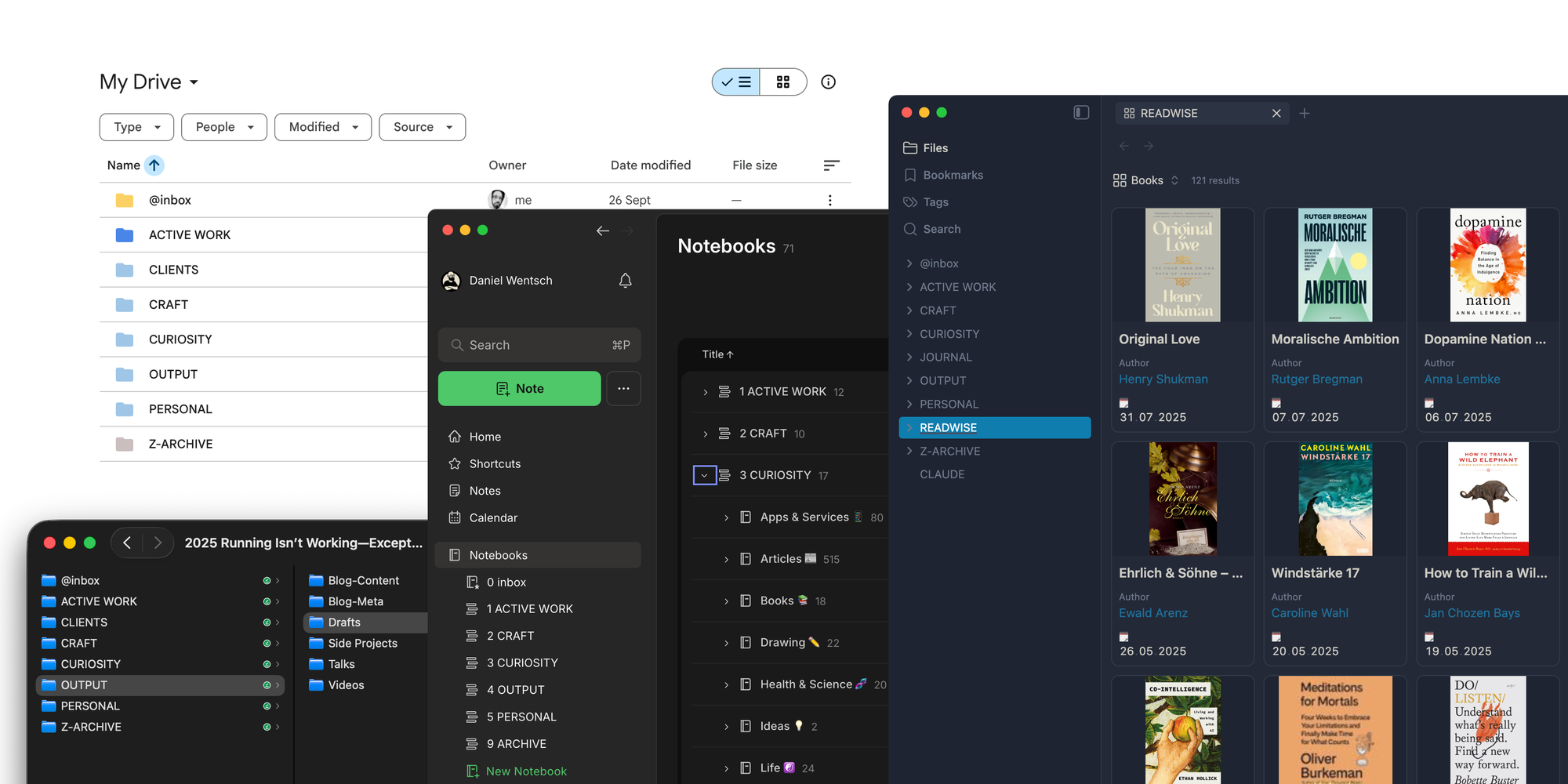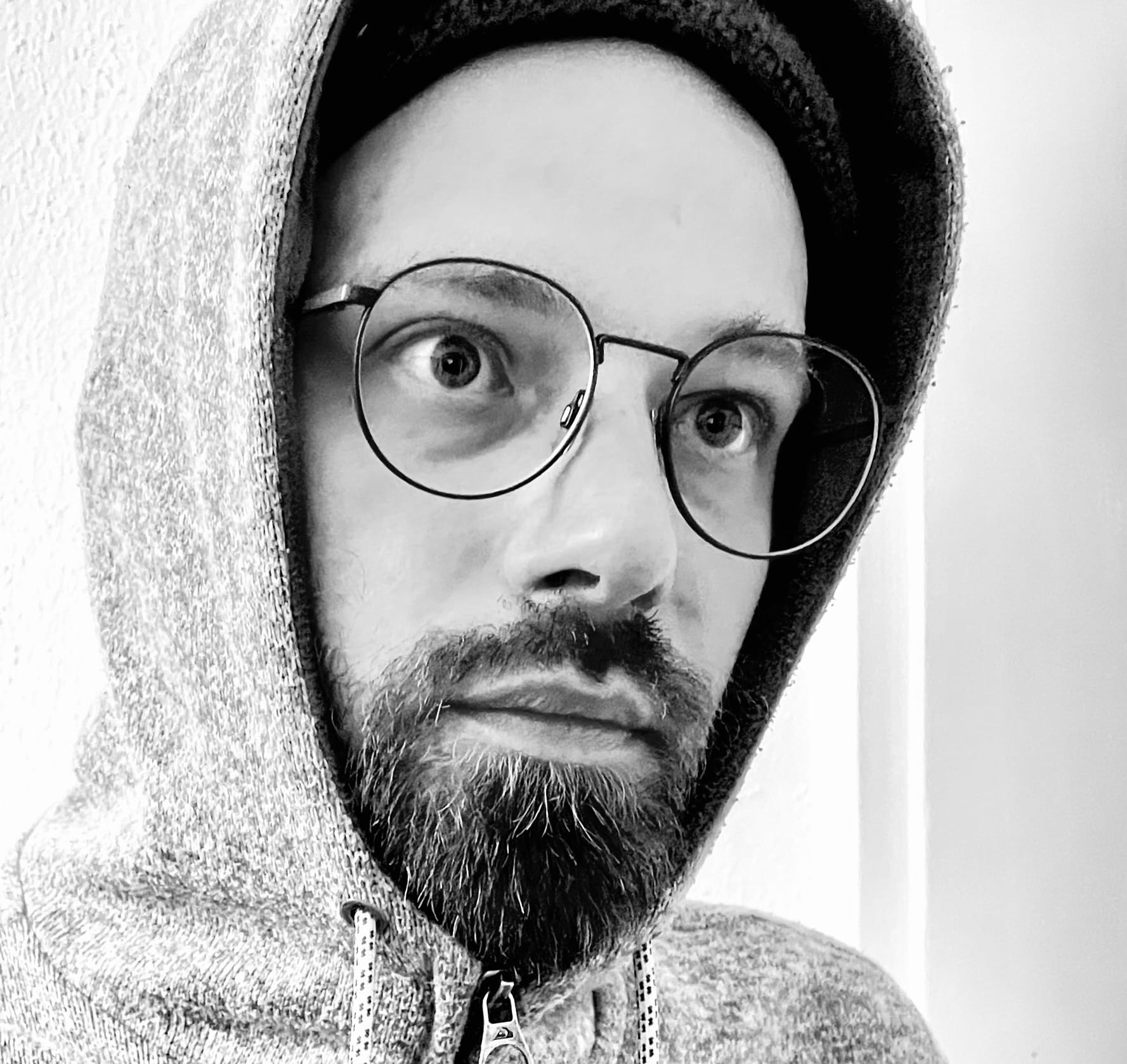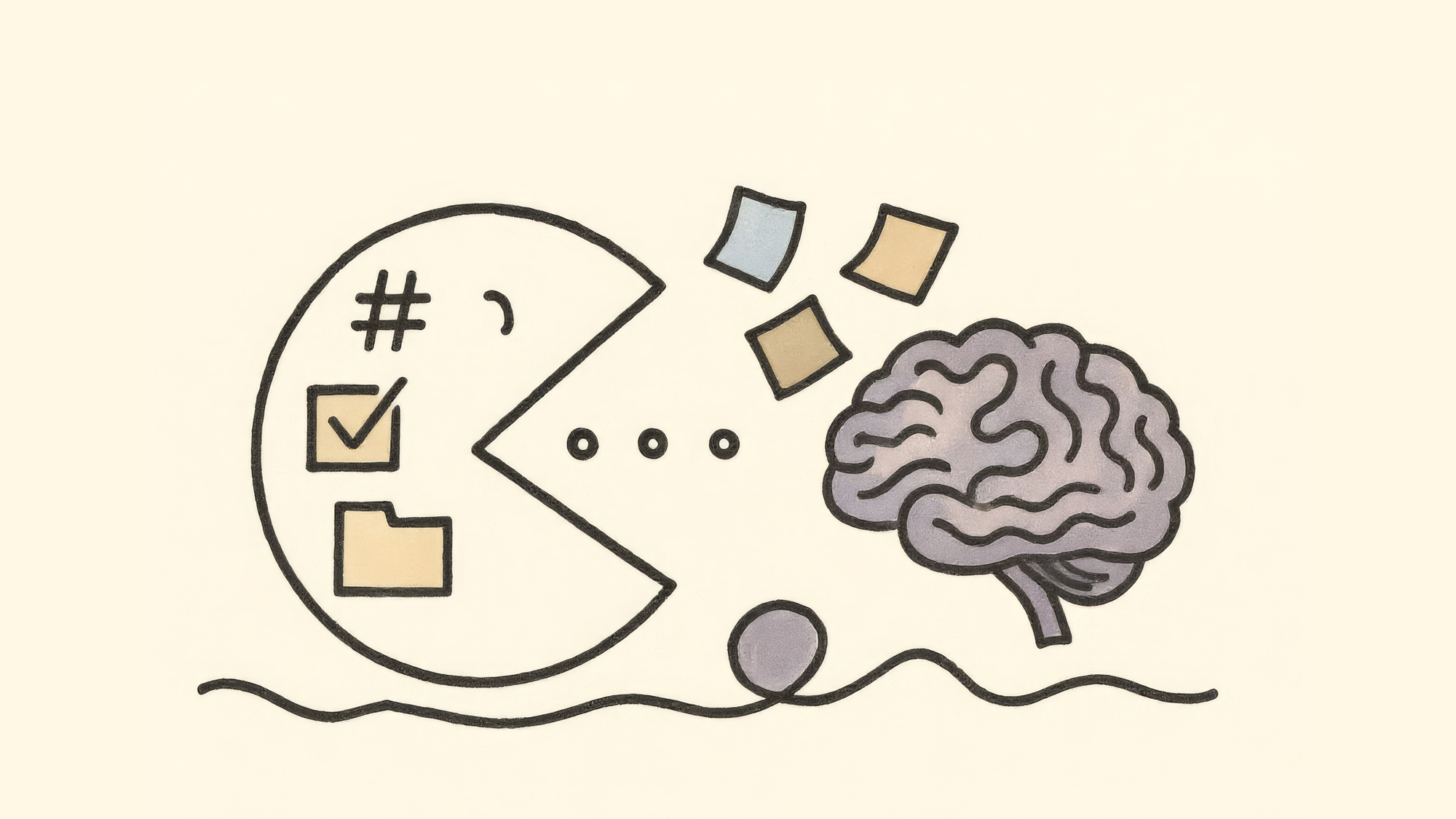I've just moved 200 notes from one folder to another. Restructured the tags. The system is cleaner now. More logical.
Still haven't written a single word of the actual article I sat down to write three hours ago.
The promise was simple: build a second brain, capture everything, and watch insights emerge organically. Tiago Forte's CODE method. Niklas Luhmann's Zettelkasten. The whole PKM community nodding in agreement.
Years later, I have some 4,000 notes across five different apps. My output? Roughly the same as before I started.
The Fantasy
The pitch is intoxicating. You can externalize your memory. Create perfect recall. Build a network of ideas so sophisticated that insights emerge organically.
Just follow the CODE method. Capture, Organize, Distill, Express.
Knowledge Graphs are even better. Link everything. Connect anything. The hard work is magically done for you. You don't have to decide what's important—the graph decides. You don't have to focus on one thing—link them all. You don't have to finish projects—just keep taking cute little notes.
Niklas Luhmann did it. He produced 70 books and 400 papers. All thanks to his Zettelkasten of 90,000 index cards.
So I tried to replicate it.
Here's what the PKM gurus don't mention: Luhmann spent three decades focused on systems theory. One domain. That was his entire research life.
He had a tenured position. Uninterrupted time. Support staff. He worked with physical index cards—no notifications, no browser tabs, no "quick check" of anything.
My reality: client work, side projects, family logistics, shifting priorities every other week. No single domain. No quiet research blocks. Just the regular chaos of trying to get things done.
The method that worked for him can't work for me. The constraints don't translate.
When Organization Replaces Creation
Six months into my PKM journey, I had perfect folder hierarchies. Tags with emojis to make them scannable. Templates for every note type.
Zero published articles.
Everything I encountered became something to process. Books were highlight sources. Conversations were note opportunities. Ideas were items to file correctly.
I wasn't thinking anymore. I was categorizing.
Sasha Chapin calls this “a fantastic way to avoid creating things”. Joan Westenberg spent years collecting compulsively, then deleted everything. What she found: “A comforting silence where the noise used to be.”
I haven't deleted mine. But I get the impulse.
The App Carousel
Every new PKM app starts the same way. Fresh install. Clean slate. This time will be different.
The first week is electric. I'm migrating notes, setting up structure, discovering features. Look at these beautiful nested tags. Block-level transclusion. Visual canvases. Finally, a system that makes sense.
Week three, the shine's gone. My Daily Notes folder has gaps. The templates feel rigid. Half my notes don't fit the structure anymore.
So I research alternatives.
Dan Shipper explains the pattern: switching tools stimulates dopamine, which temporarily boosts motivation. It also breaks the negative associations you've built up with your old setup—all those uncompleted tasks staring at you.
So you switch. Fresh start. Clean slate.
The new app isn't better. It's just new.
Sébastien Dubois ran the numbers. Thirty minutes a day tweaking tools instead of using them adds up to 182 hours a year. Over four full work weeks.
I've probably lost more than that.
After two weeks with Roam Research, Justin Murphy's knowledge graph was "utterly unintelligible and distressing." He calls it combinatorial explosion.
Mine looked the same. A web of links connecting everything to nothing.
The graph wasn't helping me think. It was replacing my thinking.
Taking vs. Making
There's a difference between note-taking and note-making.
Note-taking is capture. Passive recording. Copy-paste enlightenment.
Note-making is synthesis. Active creation. Wrestling with ideas until something new emerges.
My system optimized for taking. Not making.
I accumulated thousands of highlights. My capacity for original thought atrophied.
Most of my notes are quotes from other people's thinking. Very few are mine.
The Simplicity on the Other Side
Leonardo da Vinci kept everything in one book. Liked something? Put it down. That was the system.
It worked for Leonardo.
Joan Westenberg's approach after deleting her second brain: write what she thinks, delete what she doesn't need, don't try to capture everything. She keeps one note called WHAT for things she needs to remember. The important stuff finds its way back.
Sasha Chapin puts it plainly: your natural sense of what matters is a better filter than any system. When you rely on something else to tell you what's interesting, you stop noticing what actually sticks in your own mind.
I'd been saving what I thought I should find interesting. Not what genuinely mattered to me.
That's backwards.
What I Was Really Doing
Dan Shipper nailed something I'd been avoiding: we use productivity tools to regulate our emotions, not get stuff done.
My PKM system wasn't about organizing knowledge. It was about managing anxiety.
Anxiety that I'd lose something important. Anxiety that I wasn't doing enough. Anxiety that without the right system, I'd fail at... something. Everything.
Building the system felt like progress. Reorganizing folders gave me completion. Trying new apps gave me hope.
The actual work—writing, creating, building things—sat untouched.
Because that's where the real risk lives. That requires showing up. That means possibly failing at something that matters.
Easier to rearrange digital files.
What Actually Works
I still don't have this figured out. Likely never will. But some patterns have emerged.
I capture less now, but differently. Used to highlight everything, save everything, keep everything just in case. Now I'm more selective. Sometimes I save something because I can articulate exactly why it matters. Other times it's just a gut feeling—this sounds good, this might be useful later, this is an example of writing I want to learn from. Both are fine. What I've stopped doing is saving things out of obligation or completeness.
The measure changed. I used to count notes, highlights, connections. Now I count finished work. Articles published. Projects shipped. Things people can actually see and use.
Forgetting is fine. Most notes never get read again anyway. Writing them helped me think through something. That was the value. The artifact itself doesn't matter much.
Break the dopamine loop by noticing it. When I'm reorganizing instead of creating, that's fear talking. Fear is uncomfortable. Creation is uncomfortable. One produces work. The other produces cleaner folders.
The Pull Never Goes Away
The urge to reorganize still hits. To try a new app. To build a better system.
It mimics progress. Feels productive. Scratches the itch for novelty and completion.
But it's not work. It's work avoidance dressed up as optimization.
Real work is slower. Messier. Doesn't give you clean checkboxes or satisfying visual graphs. You sit with uncertainty. Deal with blank pages. Risk making something that doesn't work.
Most days I manage to stay focused. Some days I spend two hours adjusting my folder structure.
Those aren't productive days. They're just comfortable ones.
Justin Murphy doesn't mince words: obsessing over keeping every idea is digital hoarding. A web of endlessly growing, hyperlinked notes isn't impressive. It's oppressive.
He's right.
I don't need a complete archive of everything I've ever read or thought. I need space to think about what matters now.
Memory that forgets gracefully. Ideas that resurface because they're actually relevant, not because I indexed them correctly.
What I'm Doing Differently
My current setup is messy, but it works: Daily Notes in Obsidian for thinking out loud. Todoist for tasks, synced to my calendar so I actually see what needs doing. Evernote for project documentation that needs to outlive the project.
That's it. No single source of truth. No perfect integration. Just tools that match different needs. Some parts live in multiple places, that is okay.

I keep roughly the same high-level structure across apps—inspired by PARA but adapted: ACTIVE WORK, CRAFT, CURIOSITY, OUTPUT, PERSONAL, ARCHIVE. It's simple enough to remember, flexible enough to actually use. The details of that system are another article.
When I read something worth keeping, I take some highlights, and Readwise syncs them to Obsidian and Evernote. And whatever app I’ll be unsing next month. Sometimes I save things with just a gut feeling they'll be useful. What I don't do anymore is save everything out of obligation.
Why This Actually Matters Now
Here's something I didn't expect: my scattered collection of notes has become more useful in the age of AI, not less.
All those years of journaling. The observations about my app-hopping patterns. Random design inspiration I collected because something looked good. Examples of writing that worked. Technical snippets I saved with a vague sense they'd matter later.
Turns out, having a record of what you find good—your taste, your style, your preferences—is increasingly valuable when anyone can generate infinite amounts of mediocre content in seconds.
Claude doesn't know how I write. But when I can point to my style guide, examples from my journal, patterns in how I think—because I wrote them down—I can get something that sounds like me instead of generic AI slop.
Same with design work. "Make it look good" produces nothing useful. "Here are five examples of interfaces I collected because they felt right" gives an LLM something to work with.
The notes aren't a second brain. They're more like a mirror. Patterns in my thinking become visible because I kept writing down my thinking. What I value becomes clear because I documented what caught my attention.
The diffuse gut feeling I had when saving something? That was often right. Not because the note itself was valuable, but because the act of noticing—this matters to me—was the valuable part.
Style and taste aren't things you can prompt engineer from scratch. They're things you develop by paying attention to what resonates. Having that documented doesn't make you productive. It makes your work yours.
In an era where speed and volume are trivial, specificity and authenticity are what matter. My messy collection of notes gives me both.
Not because the system is sophisticated. Because I've been paying attention.
What They Don't Say in the Sales Pitch
Perfect PKM systems don't exist. Not in the way they're sold.
The pitch is total capture. Flawless organization. Ideas that emerge automatically from your carefully tended knowledge graph.
What you actually get: endless configuration, tool-switching as therapy, and a sophisticated way to avoid doing real work.
Your brain already knows how to think. It doesn't need a perfect external system. It needs time, space, and permission to work the way it actually works—which is often messy and nonlinear.
I've built elaborate systems. Multiple times. They mostly just created distance between me and my work.
The only second brain that matters is what you actually make. The rest is just infrastructure.
My Obsidian vault is still a mess. Evernote still holds notes I haven't looked at in years. I'll probably try another app next year.
But last week I shipped three articles. Finished a client project. Made progress on things that matter.
The system is imperfect. The work is real.
Joan Westenberg said it best: “I don't want to manage knowledge. I want to live it.”
That's the goal. Not perfect capture. Not flawless organization.
Just making things that didn't exist before.
The notes will come along for the ride. Or they won't.
Either way, I'm done reorganizing.


Discussion